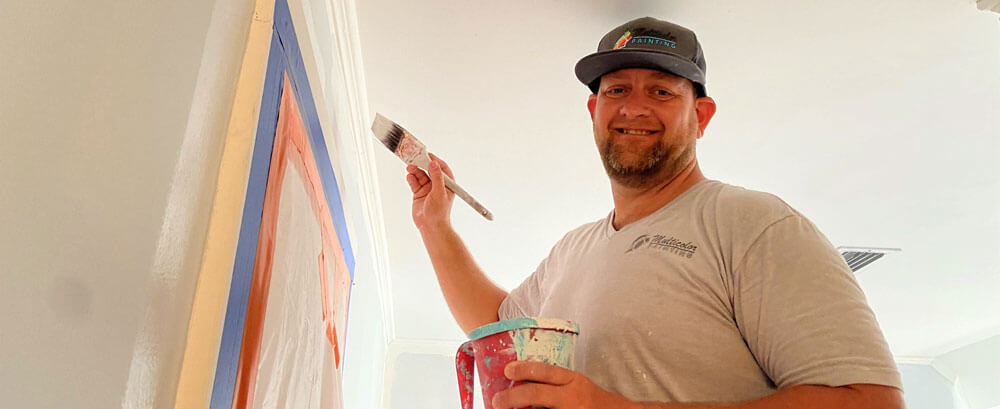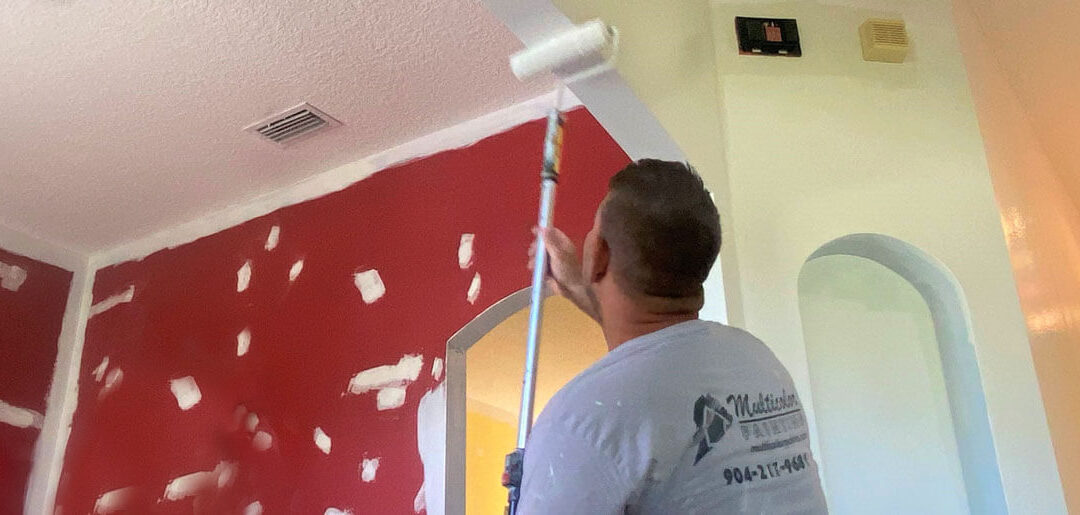Painting the ceiling and slanted walls presents its own optical and technical challenges, which we will explain further in this article. The most important aspect to keep in mind is that slanted walls make your space look narrower. The best solution is to pick light shades in these rooms and use bold or darker complementary colors or wallpaper only in small areas.
What should I look out for when painting slanted walls?
Painting attic room slanted walls requires the same technique as painting the ceiling. If you do not have much experience painting, make sure to do the job during daylight or leave it to a professional. It is easy to make small mistakes in artificial lighting, even more so when painting the attic. Believe me, this is really important, I know from over 10 years of painter experience.
A few tips for easy and successful attic painting
As a professional I work fast with a paint brush from a ladder, but without experience, I recommend you use some aids to make your life easier: a paint roller and a telescopic pole. You should dip the paint roller in the paint more often instead of putting too much paint on it all at once. Then, use a paint roller grid to get the excess paint off your roller. This prevents the paint from dripping.
Just like with ceilings, we advise using a thick topcoat paint, which makes application easier. Before you start painting, make sure you have a protective hat and glasses!
Always paint away from the light, starting from the windows!
It is important to work at a good pace. This does not mean that you should not take a few minute breaks, but the already applied paint should be wet when you continue your work. If the paint dries halfway through, the finished work will be spotty because you cannot blend the different layers evenly.
Take care to mix your chosen Sherwin Williams paint well before you start using it. The surface of the wall must be appropriately solid, dry, and free from any oils and dust. Additionally, always apply deep primer before painting.
Make the primer visible!
5-10% of wall paint mixed in the deep primer makes application easier and distinguishes the surfaces that have already been covered from those that still need to be painted. First, the wall paint must be mixed in equal parts with the deep primer; then, the mixture can be easily mixed with the rest of the deep primer. With the wall prepped and ready, the deep primer needs to be applied in one, or a maximum of two coats.

How to make painting the ceiling simple:
The ceiling needs to be painted crosswise, so apply the strokes of paint along the width of the room. These strokes should not be wider than what you can effortlessly reach from a ladder or with an extension pole. This usually means working in sections of a maximum of one and a half meters in width and three meters in length. These sections will easily blend as long as the paint stays wet. To achieve the best results, rolling should always be parallel to the main light stream in the room.
How to make ceiling look lower?
I often find that in two-story homes or homes with a loft, the ceiling can be too high. I choose medium light shades for these ceilings, especially if the walls are light colored. This helps bring the ceiling “down” a bit optically. If you put stucco between the wall and the ceiling, paint it darker than any other painted surface! This also helps make the ceiling look lower.
Why Should You Hire a Professional Ceiling Painter?
Painting a ceiling can be a daunting task. It’s not just about applying paint to the surface. There are several factors to consider, such as the type of paint, the surface preparation, and the equipment needed. If you’re not experienced, you can end up with an uneven and unprofessional finish. Here are some reasons why you should hire a professional ceiling painter:
- Experience and Expertise: Professional ceiling painters have years of experience and expertise in painting ceilings. They know the right techniques and equipment to use to get the job done right.
- Quality Results: A professional ceiling painter will ensure that the finish is even and consistent. They have the expertise to handle any challenges that may arise during the project.
- Time-Saving: Painting a ceiling can be a time-consuming task. A professional ceiling painter can get the job done quickly and efficiently, saving you time and effort.
- Safety: Painting a ceiling can be dangerous, especially if you have a high ceiling. A professional ceiling painter has the equipment and expertise to work safely and avoid accidents.
Feel free to give me a call! I’ll do an in-person survey and give you a customized quote! Call now ceiling painter Florida: 1(904)217-9681
FAQ
1. How long does it take to paint a ceiling?
The time it takes to paint a ceiling depends on several factors such as the size of the room, the condition of the ceiling, and the type of paint and finish you choose. On average, it can take between 1-3 days to paint a ceiling.
2. Can I paint my ceiling myself?
Painting a ceiling can be a challenging task, especially if you’re not experienced. It’s best to hire a professional ceiling painter who has the expertise and equipment to get the job done right.
3. What type of paint is best for ceilings?
Flat or matte paint is the best type of paint for ceilings. It has a non-reflective finish and can hide imperfections and flaws on the ceiling surface.
4. Will the ceiling painter move furniture?
Most ceiling painters will not move furniture unless it’s agreed upon during the consultation. It’s best to clear the room of any furniture or cover it with plastic sheeting to protect it from paint drips and splatters.
5. Can a ceiling be painted a different color than the walls?
Yes, a ceiling can be painted a different color than the walls. It’s a great way to add interest and dimension to your space.
6. How often should I paint my ceiling?
There’s no set timeframe for repainting a ceiling. It depends on several factors such as the type of paint, the condition of the ceiling, and the amount of traffic the space receives. On average, it’s recommended to repaint your ceiling every 5-7 years.
Read more:


